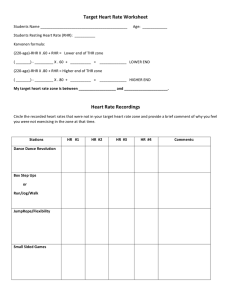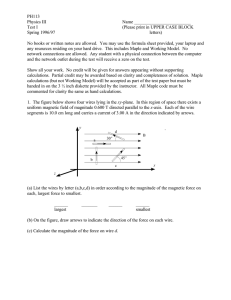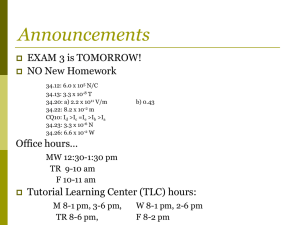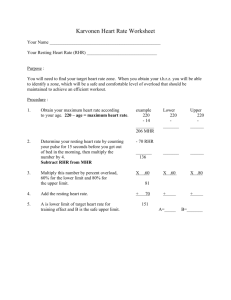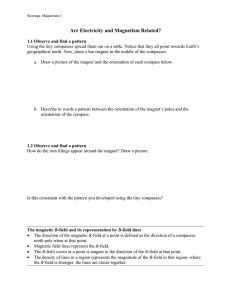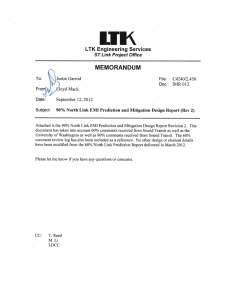Notes 20-6 to 20-9
advertisement
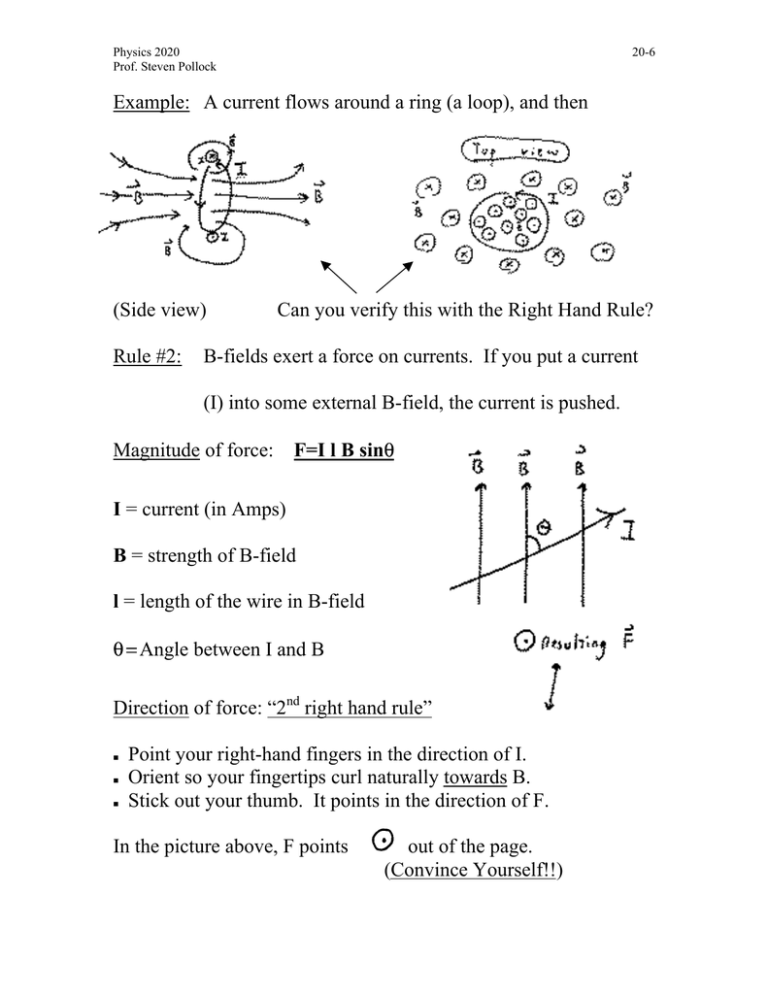
Physics 2020 Prof. Steven Pollock 20-6 Example: A current flows around a ring (a loop), and then (Side view) Rule #2: Can you verify this with the Right Hand Rule? B-fields exert a force on currents. If you put a current (I) into some external B-field, the current is pushed. Magnitude of force: F=I l B sin I = current (in Amps) B = strength of B-field l = length of the wire in B-field Angle between I and B Direction of force: “2nd right hand rule” n n n Point your right-hand fingers in the direction of I. Orient so your fingertips curl naturally towards B. Stick out your thumb. It points in the direction of F. In the picture above, F points out of the page. (Convince Yourself!!) Physics 2020 Prof. Steven Pollock 20-6 (Note: F is perpendicular to B, and to I) When a current flows around a ring, RHR #1 tells you the direction of the resulting (“induced”) B. Some people introduce another “Right Hand Rule,” which we might call “Right Hand Rule #1b” n If your right hand fingers curl with the current in a current loop, your thumb points in the direction of the B. This is different than the RHR#1, where your thumb pointed with I, and your fingers pointed like B! So don’t mix them up! You never need RHR #1b, I just find it quicker and easier when you have current loops to deal with. Physics 2020 Prof. Steven Pollock If θ = 90, F is max 20-7 Fmax = IlB e.g. So B = Fmax/Il. This in fact defines the value of B! Units [B] = N/A*m = 1 Tesla = T F= into page Convince Yourself! 1 Tesla is a lot. The Earth’s natural field is B about 0.5 * 10^-4 T. n An old unit for B was “Gauss,” 1 Gauss = 10^-4 T n So Bearth = 0.5 Gauss n Kitchen magnets are around 50G or 5*10^-3 T = 5mT n Industrial magnets = 1 or 2 T (that’s a natural limit for Iron) (This is a typical NMR field) n Superconducting magnets around 20T Ex.) Take a “horseshoe magnet” (Big B-field between poles, remember B points from N towards S) run a current, I, into the page in this big B field: (I used a dot in the figure: TYPO! I meant to use an "x" there, and can't fix it now, sorry) RHR#2 says F is up (convince yourself!). F=IlB (The length of the wire that is in the Bfield) Physics 2020 Prof. Steven Pollock 20-8 Example: Take that horseshoe magnet and orient it so “N” is in front of the page, “S” is behind. So B points into the page. Now lower a current carrying loop of wire into this Bfield. B-field is localized to this region here. There will only be Forces where the wire is in the B-field. Use the 2nd RHR, and convince yourself they look alike. The forces on the left & right cancel, there is a net force down. Easily measured with a scale. The current loop is “sucked in” to this particular B-field. If I=20A, (Typical large current in household wires) l=10cm, (Typical large horseshoe magnet width) B=1T (A very strong Fe magnet!) F=I l B=(20A)(.1m)(1N/Am)=2N. Not huge, but you could easily feel this. (This is one technique to measure a B-field.) Physics 2020 Prof. Steven Pollock 20-9 This force has nothing to do with the metal of the wire. It is really the moving charges (the current) that feels this force. E.g. A beam of protons flying through B would also feel the magnetic force, even though there’s no wire around at all. F=(I)(l)(B)sinθ Our formula for a wire. F=qVBsinθ The formula for individual particles. Where V=velocity of the particle. It’s the same formula! Because: I=Nq/t = #charges/sec V = l/t = dist/time So I*lB = (Nq/t)(l)(B) = Nq*VB (i.e. each charge feels qVB, so all N charges feel NqVB) The direction is just as before (2nd RHR) Except if the q’s are negative, the direction of F must be reversed! So e.g. F on +q is up (e.g. protons) F on –q is down (e.g. electrons)
